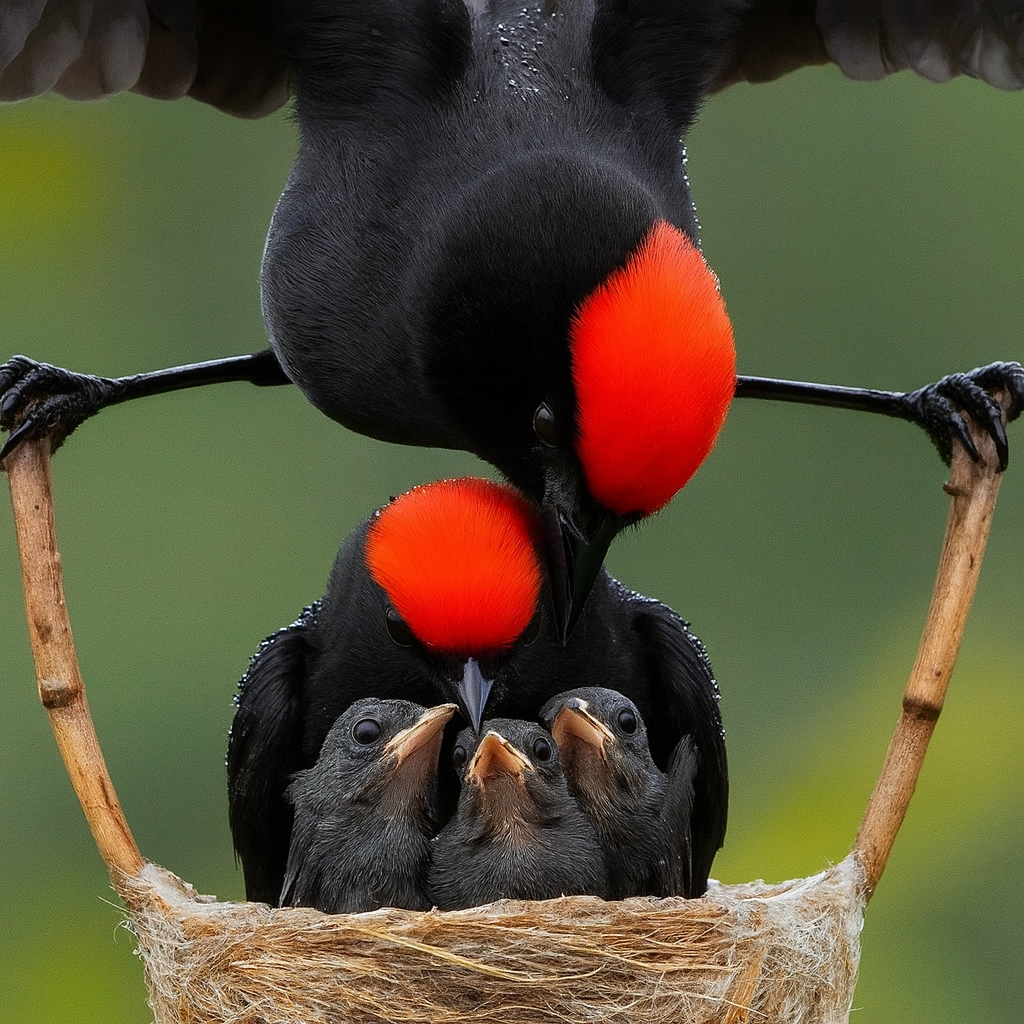⏲️ Estimated reading time: 6 min
A breathtaking image captures two adult birds with bright scarlet heads feeding their chicks in a reed nest during rain. Most likely the Scarlet-headed Blackbird, this article explores habitat, diet, breeding, nest strategies, and what we can learn from their behavior.
The photo shows an intense moment: two adults with jet-black bodies and scarlet heads, clinging to reed stalks, hovering protectively over three chicks with open beaks. Raindrops glisten on their feathers, adding a dramatic atmosphere. Based on the color and the reed-nesting context, this is most likely the Scarlet-headed Blackbird (Amblyramphus holosericeus). While this identification is probable rather than absolute (lighting and molt stages can cause variation), the combination of black plumage + bright scarlet head and reed habitat strongly supports it.
Let’s dive deeper into this fascinating species blending accessible storytelling with solid ornithological detail. Perfect for a WordPress post that educates, inspires, and raises awareness about wetland birds.
Who is the Scarlet-headed Blackbird?
Scientific name: Amblyramphus holosericeus
Family: Icteridae (related to orioles, grackles, and the Red-winged Blackbird)
Distribution: South America Argentina, Uruguay, Paraguay, southern Brazil, and Bolivia. Found in wetlands, reed beds, swamps, and marshy fields.
Appearance: Glossy black body, with a striking scarlet-red head and throat. This distinctive contrast makes it instantly recognizable.
Note: In some populations or light conditions, females may also appear very bright. Occasionally, both parents at the nest show equally vivid heads, as seen in viral photos. Cooperative breeding (helpers assisting at nests) is also sometimes observed.

Habitat: The Kingdom of Reeds
This bird thrives in wetland ecosystems: shallow lakes, reed marshes, irrigation ditches, and floodplains.
Why reeds?
- Camouflage: The black body blends into shadows, while the red head stands out mostly in courtship.
- Support for nests: Reed stalks form the framework for the cup-shaped nest.
- Abundant food: Insects, larvae, and seeds are plentiful in wetland vegetation.
For photographers, reeds offer stunning backgrounds but can confuse light metering. Slightly increasing exposure helps preserve the fiery scarlet.
Diet: Feeding Chicks in the Rain
During the breeding season, adults bring:
- Soft-bodied insects (beetles, caterpillars, dragonfly nymphs)
- Spiders (protein-rich)
- Occasionally seeds and aquatic invertebrates
Even in rain, feeding never stops. Parents time quick trips between showers, delivering food rapidly while keeping feathers as dry as possible. They also remove fecal sacs from the nest to keep it clean and predator-free.
Reproduction: Engineering the Reed Nest
- Season: Spring–summer in the Southern Hemisphere (October–January)
- Nest: A woven cup of reed fibers, grass, and roots, anchored between 2–4 reed stems (exactly as seen in the photo).
- Clutch size: 2–4 eggs, incubated for ~13–15 days.
- Chicks: Born helpless, fledging within 2–3 weeks.
Both parents share duties feeding, brooding, and guarding. In rain, one parent often acts as a living umbrella, shielding the chicks with its body.
Why Do Both Parents Look So Alike?
Possible explanations for two equally red-headed adults:
- Reduced sexual dimorphism in some populations females can be nearly as bright as males.
- Helper at the nest: a relative assisting in chick rearing.
- Lighting/post-processing effects contrast and saturation can exaggerate colors.
Regardless, the behavior cooperative chick care under harsh weather is the key takeaway.
Similar Species and How to Tell Them Apart
- Red-winged Blackbird (Agelaius phoeniceus): red shoulder patches, not a scarlet head.
- Tanagers: red extends across the body, not just head/throat.
- Northern Cardinal: full red plumage with a crest different body shape and beak.
Only the Scarlet-headed Blackbird has the signature scarlet head with a glossy black body in reed habitats.
Social Life: Songs, Territory, and Defense
- Moderate territoriality: Males sing from reed tops to mark their space.
- Song: A metallic “cling-cling” that carries across wetlands.
- Visual display: They arch wings and expose their scarlet head in dominance shows.
- Predator response: Alarm calls and distraction displays to protect the nest from snakes, herons, or rats.
Parenting Lessons from Birds
- Shared responsibility: Both adults (and sometimes helpers) alternate feeding trips.
- Adaptation to tough weather: Short, precise feeding during rain gaps.
- Cleanliness counts: Removing waste immediately to keep chicks healthy.
- Energy optimization: Choosing quick, nutritious food items to maximize efficiency.
These behaviors mirror human strategies teamwork, time management, and resource optimization.
Wetland Protection: Why It Matters
Reeds and marshes aren’t just bird homes; they filter water, provide fish nurseries, and act as natural flood buffers. Threats include:
- Drainage and agriculture
- Fire mismanagement
- Pesticide pollution
- Invasive plant species
Protecting wetlands = safeguarding the survival of Scarlet-headed Blackbirds and countless other species.
Ethical Bird Photography Tips
- Keep distance: Use a telephoto lens, not drones near nests.
- Limit time: Shoot in bursts and leave quickly.
- No flash: Sudden light stresses birds.
- Avoid trampling reeds: It leaves predator trails.
- Don’t share exact nest locations publicly.
Fun Facts
- Color origin: Carotenoids from diet pigment the feathers scarlet.
- Song: Metallic tones, sharp and carrying across marshes.
- Smart tactics: They use reed stalks as “bridges” to avoid wetting feathers.
- Symbol of resilience: A bird thriving in unpredictable wetlands, balancing risk and reward daily.
FAQ
1) Is the bird in the photo definitely a Scarlet-headed Blackbird?
Highly probable, though not 100% confirmed without location data.
2) Do both parents always look alike?
Not always males are usually brighter, but some females or helpers can appear vivid.
3) Does rain harm the chicks?
Yes, cold rain risks hypothermia but adults shield them effectively.
4) What do parents do with waste in the nest?
They remove fecal sacs to keep the nest clean and safe.
5) Can I photograph a nest I find?
It’s best to avoid it. If you do, stay distant, quick, and discreet.
Storytelling with This Image
- Emotional hook: Describe the split-second when the adult spread across reed stalks like a living bridge.
- Detail: Raindrops on plumage = symbol of resilience.
- Human parallel: Parents shielding children during storms.
- Action point: Invite readers to support wetland conservation.
Wrap-Up
From one single rain-soaked photo, we glimpse the Scarlet-headed Blackbird’s world: teamwork, adaptation, and unshakable commitment to its chicks. Whether you’re a bird lover, photographer, or conservationist, this scene reminds us how much we share with nature’s parents. A perfect story for your WordPress blog blending natural science, ethics, and inspiration.
🔔 For more tutorials like this, consider subscribing to our blog.
📩 Do you have questions or suggestions? Leave a comment or contact us!
🏷️ Tags: Scarlet-headed Blackbird, wetland birds, bird photography, bird parenting, icteridae family, reed nesting, bird behavior, wildlife ethics, wetland conservation, rain and birds
📢 Hashtags: #ScarletHeadedBlackbird, #BirdParenting, #WildlifePhotography, #MarshBirds, #Wetlands, #BirdConservation, #BirdLovers, #NaturePhotography, #Ornithology, #HelpZoneBlog
Only logged-in users can submit reports.
Discover more from HelpZone
Subscribe to get the latest posts sent to your email.

